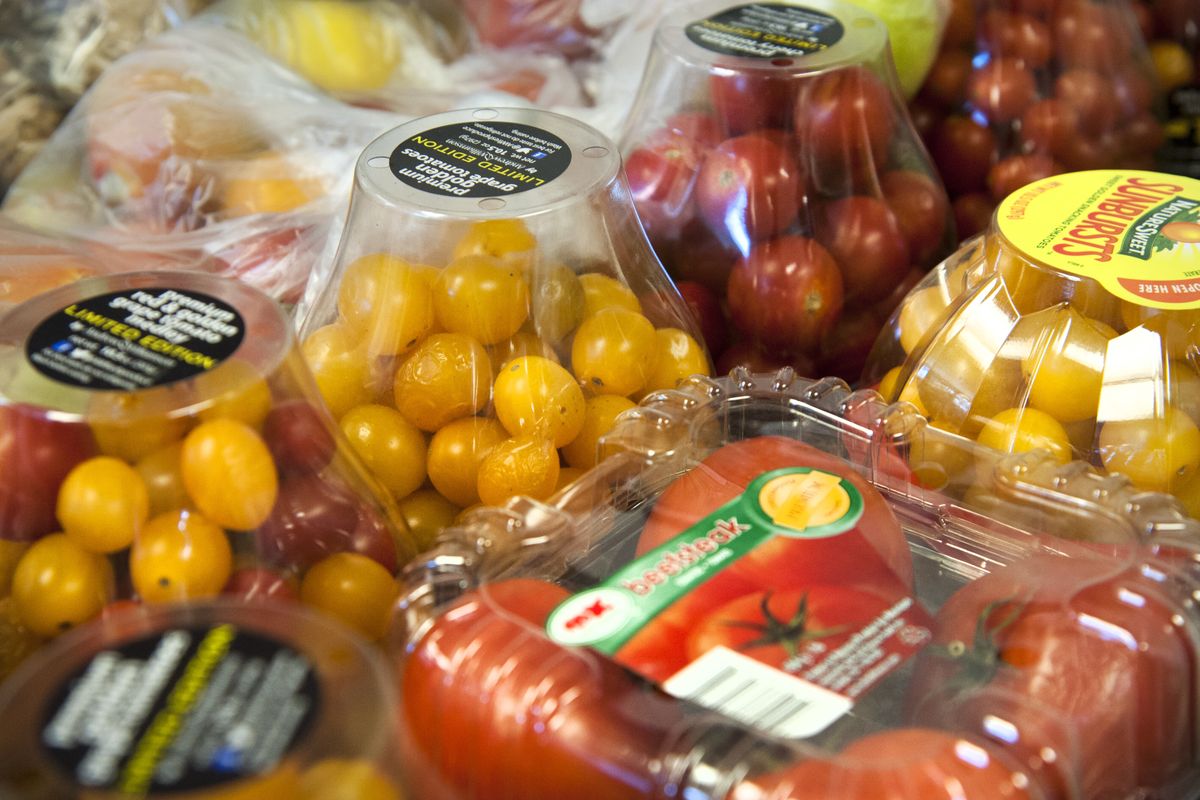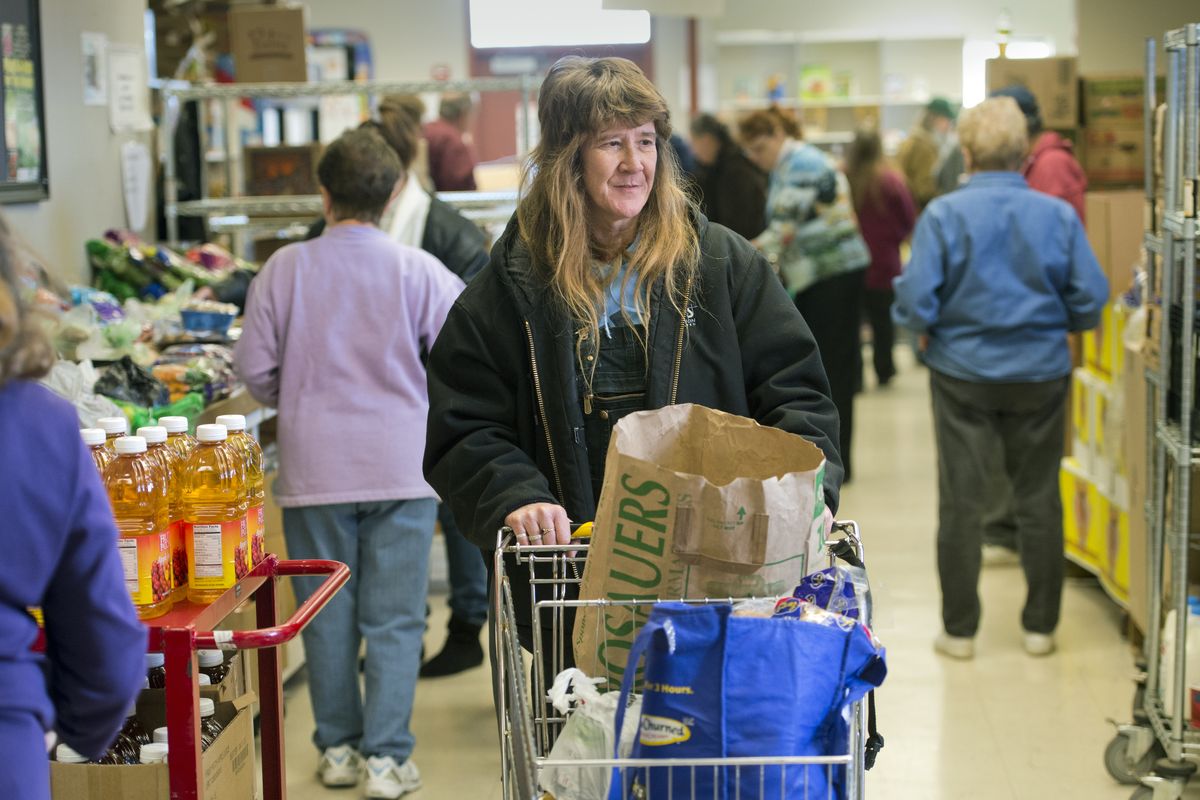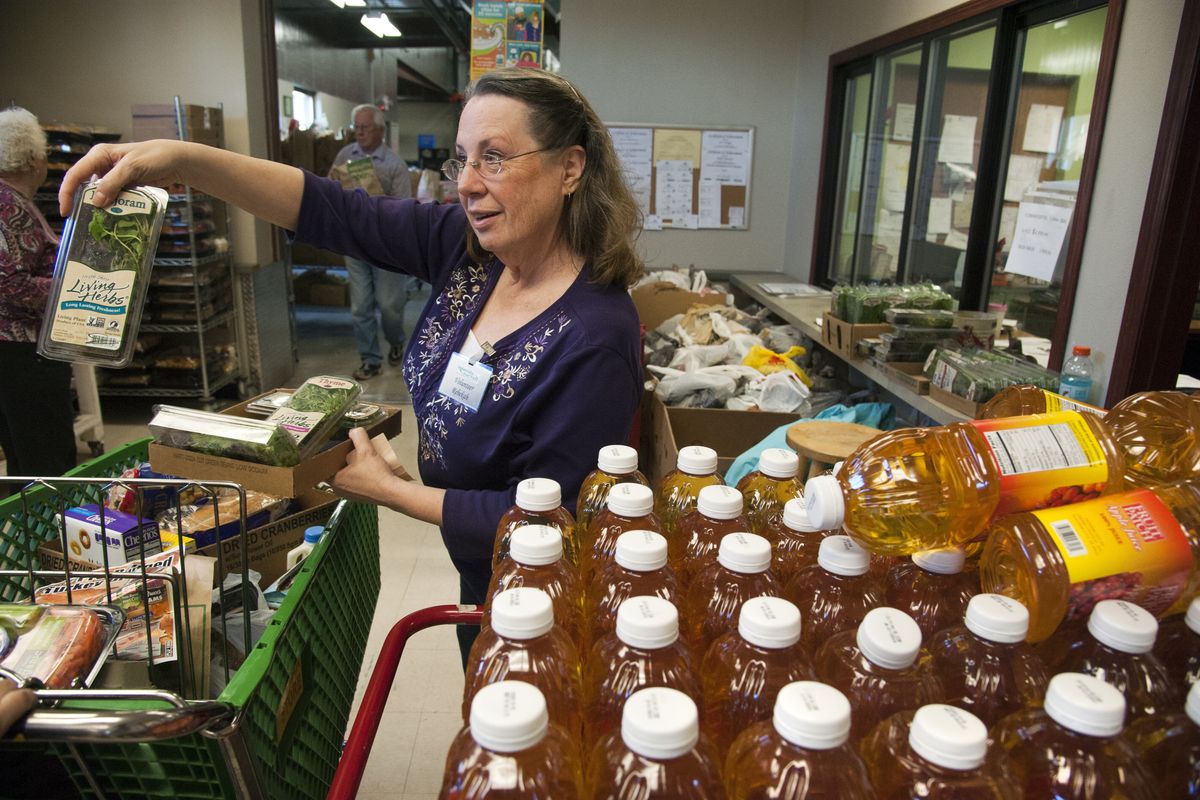Fresh and healthy on food banks’ wish lists
Spokane Valley Partners food bank volunteer Rebekah Fuller offers recipients fresh herbs, along with apple or orange juice, in the commodities section. (Dan Pelle)Buy a print of this photo
But the frosted cinnamon rolls and chocolate-chip scones packed by the clamshell into cardboard boxes in a food bank warehouse last week wouldn’t do anyone’s health much good.
As recipients steered shopping carts through the distribution spot adjacent to the warehouse – choosing rice or beans, oranges or vegetables – the CEO at Spokane Valley Partners tapped his foot against a cardboard box on a low shelf, packed with sugary baked goods.
“We’re trying to get rid of as much of this stuff as we can,” said Ken Briggs, whose organization serves 1,600 families a month through its food bank.
“Food insecurity” is linked to high rates of preventable diseases – obesity, hypertension, type 2 diabetes – and the organization is among hunger-relief groups working to offer nutritious options that can help stave them off.
It’s food-drive season, when seasonal demand ramps up at pantries and hunger-relief organizations put out a call to drum up donations. Specifically, they’re asking for “the most nutritious nonperishable food items possible,” said Melissa Cloninger, director of donor relations at Second Harvest, which provides food to 250 neighborhood food banks and meal centers in Eastern Washington and North Idaho.
In other words, not ramen noodles.
Instead, Cloninger said, the hunger-relief network encourages food-drive organizers to solicit whole-grain cereal that’s high in protein, canned meat and fish, peanut butter, hearty canned soups and stews, and beans.
One hunger-relief organization calls them “superfoods” – inexpensive, simple and nutrient-dense foods that can ward off chronic diseases linked to poor nutrition.
Historically, according to the California-based SuperFood Drive, food pantries focused on filling empty stomachs with whatever food was available. Much of it was highly processed and high in fat, sugar, sodium and corn syrup.
Cloninger said now more than half the 2 million pounds of food Second Harvest distributes monthly is “fresh and perishable” – fresh and frozen fruits and vegetables, meat and dairy foods, donated by the semi-trailer load mostly by regional farmers.
The organization amplified its outreach to growers about a decade ago as need rose and donations to local food drives fell – and as the food industry got better at cutting its own waste and, therefore, its donations, too, Cloninger said.
Second Harvest also was driven to seek farm-grown goods by the link between poverty and diet-related health problems, she said.
“I’ve had donors say to me, ‘Well, how can we be talking about starving kids when so many kids are overweight now?’ ” she said. “My response is: Because those are two factors that go hand in hand.”
But there are gaps between what’s donated and what people need to eat healthy meals.
Assistant manager Roxanne Brons said Colville Food Bank recipients can choose meat donated by stores, ranchers and hunters, “depending on what we have in the freezer.”
But she said the food bank is always in need of protein, such as canned meat, peanut butter and beans along with dairy products.
Recipients don’t come in with shopping lists, Brons said. They take what they can get: “They’re coming in because they need the food, because they are hungry.”
Some 96 percent of the 2 million pounds Second Harvest distributes monthly is donated, Cloninger said.
But when the organization spends money on food, it’s to fill in those gaps with nonperishable foods such as canned chicken and tuna, peanut butter, soups or stews. Sometimes it buys a load of produce not grown in the region.
“These are the items that most of our food banks request,” Cloninger said.
Some food-bank organizers say donations of cash, rather than food, stretch further.
The food pantry at Spokane AIDS Network buys some food with grant money and donated cash and receives more through Second Harvest and Northwest Harvest, a statewide hunger-relief organization.
Donations can be unpredictable and sometimes impractical. SAN has shelves stacked with industrial-size cans of pears.
Volunteers and staffers know what their clients need and where to get the best deals, said Ariel Holcomb-Hockin, a case manager.
When it comes to spending money on food, it prioritizes protein. But SAN’s clients have special food needs depending on their health. Longtime inflammation can lead to cardiac problems. People with wasting syndrome – the loss of body weight, especially muscle – need to adjust their diets, too. Homeless clients need food with pop-top lids.
“We try to have a really diverse array of things available to meet those different needs,” Holcomb-Hockin said.
Spokane Valley resident Mona Bearshears, 51, carpooled to Spokane Valley Partners last week and left with a cartful of food – a turkey, a bag of oranges, bread, a dozen eggs, milk. She said Spokane Valley Partners runs “one of the better food banks,” judging by what she’s heard from friends – its organizers seem to put thought into the quality and variety of food it offers.
Bearshears said she avoids junk food and tries to eat fruits and vegetables, using food stamps to fill in her own gaps when fresh produce is scarce at the pantry.
Nutrition is “always a concern,” Bearshears said. “But I do pretty good with what I have.”


